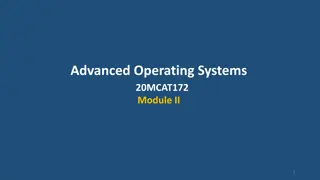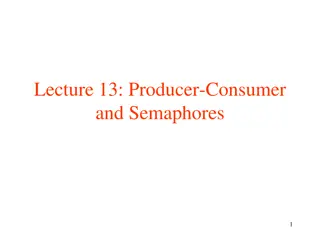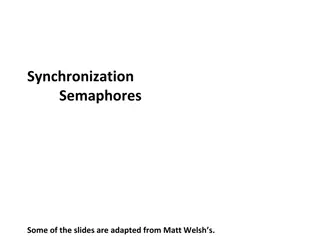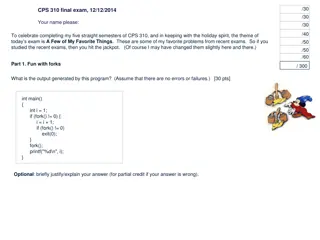Processes and Interactions
Processes in operating systems involve executing programs on CPUs, with each process having its own CPU. Processes run concurrently and can cooperate or compete for resources. Defining, creating, and managing processes is crucial for system efficiency and performance. Precedence relations, semaphore
1 views • 38 slides
Understanding Distributed Mutual Exclusion in Operating Systems
In distributed systems, the problem of mutual exclusion arises when multiple sites/processes need to access shared resources concurrently. Unlike in single-computer systems, distributed systems lack shared memory, leading to the need for communication-based approaches rather than shared variables li
0 views • 49 slides
Carnegie Mellon Synchronization and Computer Systems Lecture Updates
Carnegie Mellon's recent announcements include lab checkpoints and finals deadlines, as well as the release of an optional lab extension for the Shark File System. The lecture topics cover races, mutual exclusion, deadlock, semaphores, events, queues, reader-writer locks, starvation, and thread-safe
0 views • 43 slides
NASA Platform Layer Updates for the CAELUM (7.0) Release
The National Aeronautics and Space Administration (NASA) discusses platform layer updates for the CAELUM (7.0) release of the Core Flight System in the 2021 Flight Software Workshop. The platform layer consists of the Operating System Abstraction Layer (OSAL) and Platform Support Package (PSP), whic
1 views • 20 slides
Understanding Message Passing Models in Computer Science
Message passing models in computer science involve concepts like producer-consumer problems, semaphores, and buffer management. This content explores various scenarios such as void producers and consumers, as well as the use of multiple semaphores. The functions of message passing are detailed, high
0 views • 50 slides
Understanding Multithreading in Computing
Exploring the realms of multithreading in computing delves into topics like shared variables, synchronization with semaphores, thread safety, reentrancy, races, and deadlocks. The content illustrates the differences between the traditional and alternate views of a process, the structure of a process
0 views • 44 slides
Understanding Classical Inter-Process Communication Problems
Classical Inter-Process Communication (IPC) problems such as the Dining Philosophers Problem and the Readers and Writers Problem are explored in-depth by Ali Akbar Mohammadi. The challenges, solutions, and non-solutions to these problems are discussed, shedding light on issues like starvation in con
0 views • 15 slides
Mastering Concurrency in Operating Systems: Tips and Strategies
Explore intricate concepts in operating systems concurrency from Chapter 6 of CS 345. Learn practical tips and techniques such as determining the size of arrays, managing readers and writers using semaphores, and tackling the Barbershop Problem. Dive into array manipulation, semaphore usage, and pri
0 views • 37 slides
Managing Critical Resources in Concurrent Processes
Concurrent processes can enhance performance but require careful handling of critical resources to prevent inconsistency. Utilizing semaphores for mutual exclusion and synchronization can help control access to shared resources. This article discusses the principles of concurrency, issues with inter
0 views • 18 slides
Principles of Operating Systems Synchronization Mechanisms
Operating systems utilize high-level synchronization mechanisms such as semaphores, condition variables, and monitors to provide synchronization beyond mutual exclusion. Semaphores are abstract data types that offer mutual exclusion to critical sections, while condition variables model uncounted eve
0 views • 21 slides
Understanding Producer-Consumer Problem and Semaphores
This content delves into the intricacies of mutual exclusion solutions for producer-consumer problems, focusing on software and hardware solutions. It discusses avoiding busy waiting using sleep and wakeup functions, along with examples and illustrations. The aim is to enhance understanding of semap
0 views • 18 slides
Synchronization and Concurrency Best Practices
This content delves into essential concepts and best practices related to synchronization and concurrency in software development. It covers topics such as locks, condition variables, semantics, and semaphores, providing insights on how to ensure thread safety, manage shared data structures, and avo
0 views • 13 slides
Higher-Level Synchronization with Semaphores at Carnegie Mellon
Discover how Carnegie Mellon University explores higher-level synchronization primitives such as semaphores for effective thread management. Learn about the design and operations of semaphores, and compare them with traditional locking mechanisms. Dive into code examples and visual illustrations to
0 views • 40 slides
Understanding Semaphores in Operating Systems
Semaphores are a higher-level synchronization mechanism used in operating systems to manage critical regions. They provide mutual exclusion and can also function as atomic counters. Semaphores have two main operations - wait and signal - to control access to shared resources. By blocking waiters and
0 views • 38 slides
Concurrency Control and Coordinator Election in Distributed Systems
This content delves into the key concepts of concurrency control and coordinator election in distributed systems. It covers classical concurrency control mechanisms like Semaphores, Mutexes, and Monitors, and explores the challenges and goals of distributed mutual exclusion. Various approaches such
0 views • 48 slides
CPS 310 Final Exam - A Few of My Favorite Things
In this CPS 310 final exam, a series of challenging problems are presented related to processes, system calls, synchronization, and threading. From analyzing fork() operations to fixing plumbing sequences, implementing monitors using semaphores, and synchronizing threads for a sleeping professor and
0 views • 9 slides















